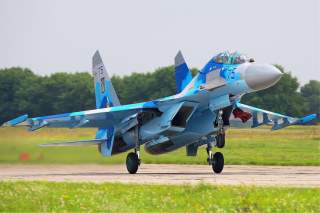Russia's Deadly Su-27 Fighter: Everything You Need Know
The plane that everyone is talking about...
For such a remarkable aircraft, the Su-27 has seen relatively little combat. It has flown combat missions in several theaters across the world, although it has yet to serve in a sustained air superiority campaign. Flankers flew in some of the wars that characterized the disintegration of the Soviet Union, and have constituted the core of Russian airpower in the Wars of Russian Reconsolidation. Indeed, Su-27s have flown on both sides of the spasmodic conflict in Ukraine. Su-27s in Russian service also currently fly in Syria. In foreign service, the Su-27 has flown in the Angolan Civil War and the Ethiopia-Eritrea War, scoring its only air-to-air victories (over Eritrean MiG-29s) in the latter.
To the West, most of the legendary Soviet aircraft of the Cold War came from the design bureau Mikoyan Gurevitch, which spawned such aircraft as the MiG-15 “Fagot,” MiG-21 “Fishbed,” MiG-25 “Foxbat” and MiG-29 “Fulcrum.” The single best Soviet fighter of the Cold War, however, was Sukhoi’s Su-27 “Flanker.” Intended both to defeat U.S. fighters over central Europe in a NATO-Warsaw Pact conflict and to patrol the airspace of the Soviet Union against U.S. bomber incursions, the Su-27 survived the end of the Cold War to become one of the world’s premier export fighters.
Origins
The Flanker emerged as part of the high part of the high-low fighter mix that both the United States and the Soviet Union adopted in the 1970s and 1980s. In the U.S. Air Force this manifested in the F-15 and F-16; in the U.S. Navy, the F-14 and F/A-18. The MiG-29 “Fulcrum” played the light role in the Soviet partnership.
Sukhoi designed the Flanker with the capabilities of the F-15 Eagle firmly in mind, and the aircraft that emerged resembles the fast, heavily armed, long-ranged Eagle in many ways. Whereas the Eagle looks healthy and well-fed, the Flanker has a gaunt, hungry appearance. Although designed as an air superiority aircraft, the Su-27 (much like the Eagle) has proven flexible enough to adapt to interceptor and ground strike roles. Sukhoi has also developed a wide family of variants, specialized for particular missions but retaining overall multirole capabilities.
The Su-27 entered service more slowly than its fourth-generation counterparts in the United States (or the MiG-29, for that matter). A series of disastrous tests bedeviled the program’s early years, with several pilots dying in early versions of the Flanker. As it entered service in the mid-1980s, production problems slowed its transition to front-line status. And of course, the end of the Cold War curtailed the overall production run of the aircraft.
The Su-27’s capabilities are formidable. The Flanker can reach Mach 2.35 with a thrust-to-weight ratio above one (depending on fuel load). It can carry up to eight air-to-air missiles (generally of short to medium range; other variants specialize in Beyond Visual Range combat) or an array of bombs and missiles. In the hands of an experienced pilot, the Su-27 can carry out a bewildering array of maneuvers, many of which have delighted air show audiences across Russia and Europe.
The basic Su-27 frame has proven remarkably flexible. The Russian Air Force has modified most of its existing Flanker fleet with a variety of advanced avionics, improving its air-to-air capacity and also giving it an effective ground attack capability. Several Flanker variants have acquired their own designations, especially on the export side.
Export
The original version of the Flanker has enjoyed tremendous export success, and still flies in eleven air forces around the world. The bulk of aircraft fly in Russian (359) and Chinese (fifty-nine) service. In some smoldering conflicts (Russia-Ukraine, Ethiopia-Eritrea, Vietnam-China) both sides fly Su-27s. Overall, 809 Flankers have entered service, plus large production orders for several variants.
The transfer of Su-27s to China caused a surprising amount of friction between Moscow and Beijing. China purchased some Flankers off the shelf, agreed to coproduce another batch, and acquired a license for production of additional aircraft. However, Russia soon accused China of violating the terms of the agreement by installing its own avionics on the J-11 (as the Chinese designated their own Flankers), appropriating Russian intellectual property and developing a carrier variant (eventually the J-16). The dispute cooled Russian enthusiasm for arms exports to China, a situation that persists today.
Combat
For such a remarkable aircraft, the Su-27 has seen relatively little combat. It has flown combat missions in several theaters across the world, although it has yet to serve in a sustained air superiority campaign. Flankers flew in some of the wars that characterized the disintegration of the Soviet Union, and have constituted the core of Russian airpower in the Wars of Russian Reconsolidation. Indeed, Su-27s have flown on both sides of the spasmodic conflict in Ukraine. Su-27s in Russian service also currently fly in Syria. In foreign service, the Su-27 has flown in the Angolan Civil War and the Ethiopia-Eritrea War, scoring its only air-to-air victories (over Eritrean MiG-29s) in the latter.
The Su-27 was the last of the major fourth-generation fighters to enter service, and has proven an exceedingly successful design. Big enough and powerful enough to sustain a number of modifications and improvements, the Flanker should continue to see service (and even production) for quite some time. This is especially true given the uncertainty associated with the future of the PAK FA, the fifth-generation stealth fighter intended to replace both the MiG-29 and the Su-27.
Robert Farley, a frequent contributor to the National Interest, is author of The Battleship Book. He serves as a senior lecturer at the Patterson School of Diplomacy and International Commerce at the University of Kentucky. His work includes military doctrine, national security and maritime affairs. He blogs at Lawyers, Guns and Money, Information Dissemination and the Diplomat.
This first appeared in July 2016 and is being reposted due to breaking events.
Image Credit: Creative Commons.

